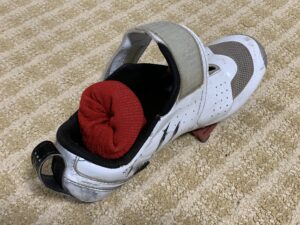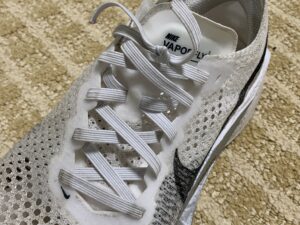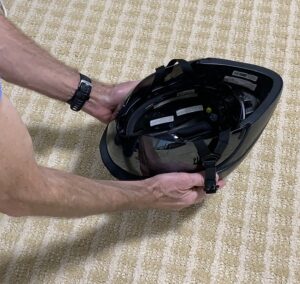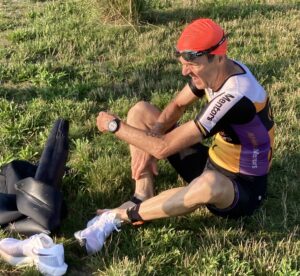 By: Jay Campbell
By: Jay Campbell
Swim, Bike, Run …. Do well at all three and you will be a good triathlete. But to be a great triathlete, you need to master what some call the ‘4th discipline’, the transition.
How important is the transition? It becomes more important in shorter races. In a 600 minute race (10 hours) the difference between a 2 minute and a 4 minute transition is less than a 1% improvement…so not that important. But if you are doing supersprint races (~30 minutes), that would be a 13% improvement!
Just to prove that I know what I am talking about, here are the top-10 fastest T1 + T2 times at the 2023 Eagle Lake Triathlon, a ‘sprint’ distance race.
|
Transitions |
1-Jay |
26 |
22 |
3 |
40 |
49 |
7 |
28 |
9 |
2 |
|
T1+T2 |
00:00:41 |
00:00:56 |
00:01:09 |
00:01:13 |
00:01:15 |
00:01:16 |
00:01:25 |
00:01:32 |
00:01:36 |
00:01:38 |
I spent a total of 41 seconds (21s in T1 and 20s in T2) in the transition area. Yes, it was a smaller, local race with a compact transition zone and limited competition…but those are factors which you must consider when developing your transition strategy. Each race will be unique and requires a different strategy. I will walk through the strategy I used for this race and suggest alternatives for other scenarios.
|
OA Finish |
2 |
1-Jay |
3 |
4 |
8 |
5 |
6 |
7 |
10 |
11 |
|
S+B+R |
00:56:28 |
00:56:58 |
00:57:35 |
01:00:20 |
01:01:55 |
01:01:58 |
01:02:19 |
01:03:04 |
01:03:18 |
01:04:03 |
In general, S+B+R times correlate with overall finishes. The main exception to that rule in this case was my superior transitions which led to yours-truly walking away with the Overall Winners Trophy and local bragging rights. Another exception was the 5th fastest S+B+R who had slow transitions did drop to 8th OA.
Before I dive into my secrets for a fast transition, let me say that if you are new to triathlon, ignore all of this. My caution to new athletes is not to ‘overthink’ the sport during your first year of racing. Just get out on the course, listen to your body, pace yourself, and be cautious during bike mounts and dismounts. There will be plenty of time in the future to dive into all the tiny tweeks that add up to measurable gains.
Are you ready? It pains me a bit to give away my secrets.
A. DEVELOP A TRANSITION STRATEGY
B. TRANSITION SKILLS (I will focus on strategies for short races as this is where transition times are more critical)
|
49 |
7 |
19 |
4 |
28 |
18 |
1-Jay |
21 |
2 |
20 |
|
|
OA Swim |
00:06:31 |
00:06:38 |
00:06:51 |
00:07:06 |
00:07:12 |
00:07:24 |
00:07:39 |
00:07:41 |
00:07:46 |
00:07:50 |
5) Donning Bike Shoes – After removing wetsuit/goggles/cap, the first thing I do is put on my biking shoes. As mentioned, I finish wetsuit removal on my butt and I put on bike shoes on my butt. [not the strategy at Eagle Lake]. Of course the pros and many of you already have shoes attached to pedals, so this does not apply to you. There is some time savings to using the shoes-on-pedals method (the 2nd and 3rd finishers at Eagle Lake used that method.) But, bike-mount and dismount are where 90% of the crashes occur in triathlon. I am too old and fragile to risk that any more. There are some good youtube videos on the shoes-on-pedals technique.
6) Donning Bike Helmet – putting on your bike helmet needs to be practiced. Place it in transition so it is one clean move from hands to head. Sliding the hands down to clip the strap.
7) Donning Biking glasses – This is an extra move but only takes a few seconds. A visor on your helmet eliminates this step.
8) Running with bike – Practice running with your bike while holding with one hand on the seat. If you are a shoes-on-pedals person, practice barefoot with the shoes attached. If you are going to wear bike shoes, practice running in the bike shoes.
9) Bike Mounting – Technically the mount happens after the transition is exited. If done sloppily it only counts against your bike time and not transition time. The object is to quickly get to speed … without crashing. Whatever your method, practice it looking forward and not at your feet. My Eagle Lake strategy was to use a ‘hop-on mount’, pedal the first quarter mile on top of the straps (it was a downhill and I wanted no distractions), then get my feet in the straps. I had practiced this enough that I could get into the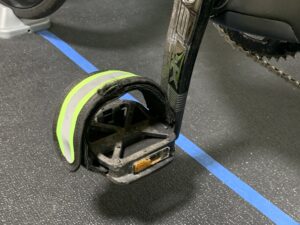 straps without looking down or using my hands. If you are using the ‘shoe-on-pedal’ method there is usually a hand adjustment once you are in the shoe. Make sure you can do this without looking. If you are using the worn-shoe method, you may want to be sure that one shoe is clipped in before hopping on.
straps without looking down or using my hands. If you are using the ‘shoe-on-pedal’ method there is usually a hand adjustment once you are in the shoe. Make sure you can do this without looking. If you are using the worn-shoe method, you may want to be sure that one shoe is clipped in before hopping on.
10) Bike Dismounting – As with the mount, this technically happens outside of transition. If done sloppily it only counts against your bike time and not transition time. In the case of Eagle Lake, I removed my feet from the straps so my running shoes were untethered on the pedals. At about 5mph I swung my right leg over and did a running dismount. I had practiced this enough I felt very comfortable doing this. Dismounting with bike-shoes flopping from the pedals is too risky for me as I mentioned earlier. If I am wearing bike shoes, I unclip my left shoe, come to a complete stop, balance on my left leg, unclip the right shoe, push the bike forward and start running behind it. The pros make it looks so easy…except when…See some of the pros struggle here: https://www.youtube.com/watch?v=140YBZF1miw&t=353s<
11) Bike racking – Generally bikes are racked on the saddle noses. The bike is usually ‘backed in’, raised, then moved forward to position the nose over the bar. That’s a lot of motions. Practice racking your bike from the ‘wrong side’ before the race starts. It may not be possible as other bikes are in the way. But when you get back from biking and the transition area has fewer bikes, you may be able to run your bike right into its spot from the rear, ditch your helmet and go.
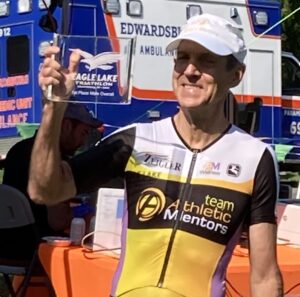 12) Helmet Removal – This may not sound like a skill, but after a duathlon at 40F with gloves on it is a whole different ballgame. My hands have gotten so cold that I lost grip strength and could not undo a chin strap clasp. I have practiced this so many times with gloves and with different parts of the hand. Reduce the movements you need to make this happen. Place the helmet where it will not get damaged by other triathletes.
12) Helmet Removal – This may not sound like a skill, but after a duathlon at 40F with gloves on it is a whole different ballgame. My hands have gotten so cold that I lost grip strength and could not undo a chin strap clasp. I have practiced this so many times with gloves and with different parts of the hand. Reduce the movements you need to make this happen. Place the helmet where it will not get damaged by other triathletes.There are thousands of small innovations and skills in triathlon that when summed up can amount to measurable gains. It’s one of the things that has kept me in the sport. Keep an open mind when planning your next transition and maybe it will kick you up a place or two!






